LED stadium lights from LedsMaster offer an unparalleled solution for sports applications, particularly when compared to metal halide, HPS, and halogen lights, thanks to their superior energy efficiency. Beyond reducing electricity costs, our football field lighting enhances user satisfaction and compliance.
Our range of flood lighting fixtures for stadiums spans from 100 to 10,000 watts, providing an impressive illumination of 15,000 to 1,500,000 lumens. Our LED sports lights are designed to save up to 75% in energy and boast an impressive lifespan of 120,000 hours. For those seeking high-power flood lights for their stadium, our engineers are ready to assist with a complimentary lighting design consultation.
Table of Contents
TogglePremium Features of Our LED Stadium Lights
Enhanced Optics
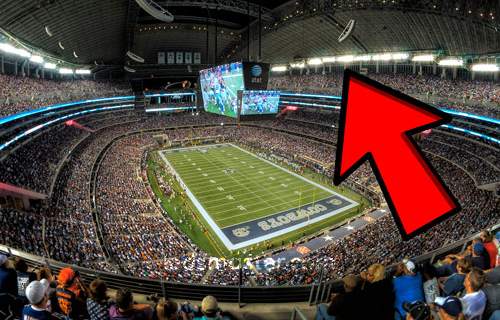 Our LED stadium lights are equipped with a cutting-edge 5th generation optic lens, which significantly boosts several key performance metrics. This advancement enhances energy efficiency, ground reach lumen, and the lighting’s anti-glare and anti-flickering capabilities by an impressive 30%. This technological leap ensures that our lights provide optimal illumination for both fast-paced outdoor and indoor sports. Whether it’s a high-energy football match or an indoor basketball game, our lighting system delivers consistent and high-quality light that accommodates the rapid movements of players and the ball.
Our LED stadium lights are equipped with a cutting-edge 5th generation optic lens, which significantly boosts several key performance metrics. This advancement enhances energy efficiency, ground reach lumen, and the lighting’s anti-glare and anti-flickering capabilities by an impressive 30%. This technological leap ensures that our lights provide optimal illumination for both fast-paced outdoor and indoor sports. Whether it’s a high-energy football match or an indoor basketball game, our lighting system delivers consistent and high-quality light that accommodates the rapid movements of players and the ball.
Superior Thermal Management
Thermal management is a critical aspect of lighting performance, and our LED stadium lights excel in this area thanks to our 3rd Generation all-in-one heat dissipation system. This advanced system features an enlarged LED base plate and densely extended fins that efficiently channel heat away from the LED chips to a circular aluminum heat sink. By effectively managing and dissipating heat, this design significantly reduces the junction temperature within the lamp body and the optic lens. Consequently, our LED stadium lights are able to maintain performance and longevity, boasting an impressive operational lifespan of over 120,000 hours.
Advanced LED Packaging Technology
Our commitment to quality is reflected in our use of Gold Wire Free Packaging, a sophisticated technology typically reserved for high-end LED products. This innovative packaging approach enhances both the efficiency and the lifespan of the LEDs. Additionally, we have upgraded the internal materials within the packaging to further ensure the durability and reliability of our lighting solutions. This attention to detail in packaging contributes to superior overall performance and longevity, making our LED stadium lights a reliable choice for various applications.
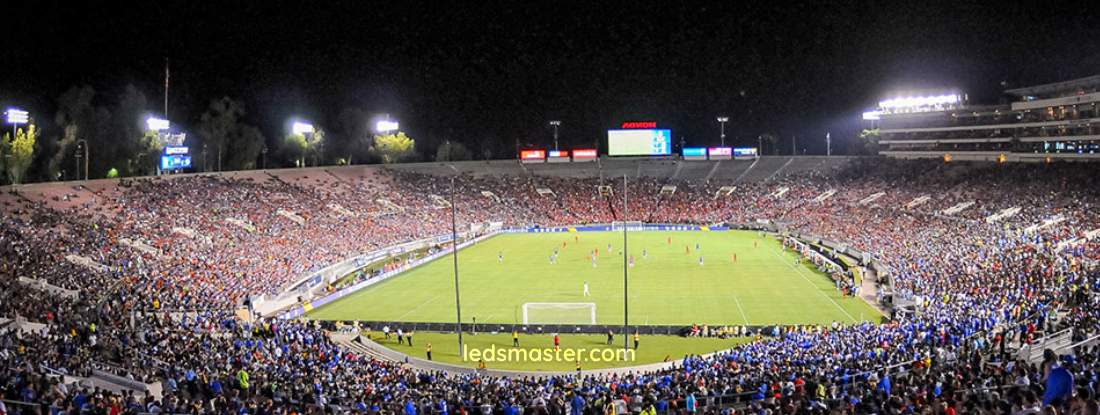
Lightweight Design
The design of our LED stadium lights prioritizes ease of installation, which helps reduce both installation costs and time. Our engineers have meticulously refined the design to create luminaires that are lighter and more compact compared to traditional models. This lightweight construction not only simplifies the installation process for new setups but also facilitates easier replacement of older lights. Whether you’re setting up new lighting or upgrading existing fixtures, our lights are designed to be straightforward and hassle-free to install.
High-Quality Illumination
Our LED stadium flood lights are renowned for their exceptional illumination quality. They offer a high color rendering index (CRI) and television lighting consistency index (TLCI) rating of over 96, ensuring accurate color representation. The lights feature a broad color temperature range from 5000K to 7000K, allowing for versatile lighting conditions tailored to different environments. Moreover, the stable DC-output power supply minimizes flicker to less than 0.3%, making our lights suitable for various applications, including general sports, professional events, and high-speed camera broadcasting.
Environmentally Friendly and Safe Materials
We take pride in the environmentally friendly and safe materials used in our LED lights. Unlike traditional lighting options, our fixtures are constructed from 6063 pure aluminum rather than diecast aluminum. We also utilize polycarbonate optic lenses instead of acrylic, and incorporate 304/316 stainless steel screws and stands instead of galvanized iron alloy. Our LEDs are free from hazardous substances such as lead and mercury, which are commonly found in metal halide and mercury lamps. This makes our lighting solutions not only safer but also more practical for a wide range of applications.
Football Stadium Lights Buyer’s Guide
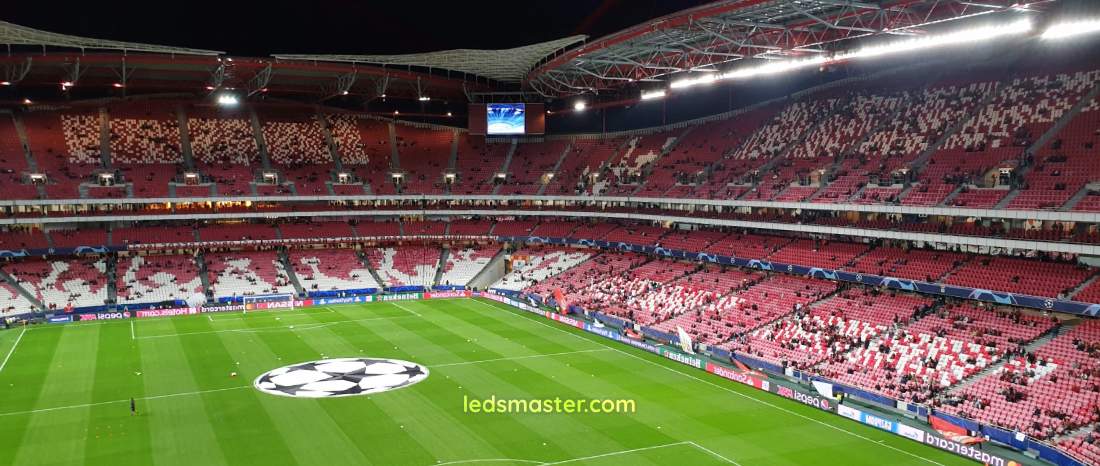
What are the best stadium lights available? Why should we consider replacing metal halide, halogen, high-pressure sodium (HPS), and mercury lamps with LEDs? What factors are crucial when selecting lighting for a football field? This article will provide insights into illuminating outdoor football fields to meet the high standards of events like the FIFA World Cup, Olympic Games, Premier League, and UEFA competitions using LED technology.
As you prepare documentation and products for a lighting tender, focusing on key factors is essential for success. The primary considerations include the requirements for lighting fixtures, such as lux levels (brightness) and uniformity.
There are various regulations governing stadium lighting. According to UEFA’s lighting guide, football fields are categorized into six levels: Elite Level A for Europa League finals, Level A for Super Cup finals, Level B for semi-final matches, and Level C for qualifying rounds, among others. The lighting standards escalate with the significance and prestige of the matches, with the highest standards reserved for the final.
Brightness of Football Fields
Effective lighting for football fields is comprised of two key components: horizontal and vertical luminance. Horizontal luminance refers to the level of light that covers the playing surface, while vertical luminance pertains to the illumination of the players’ portraits and surroundings. According to industry standards, a football stadium should achieve a horizontal luminance of 2000 lux and a vertical luminance of 1500 lux. To meet these demanding specifications, it is typically necessary to deploy hundreds of high-power LED flood lights. These powerful lights ensure that the field is uniformly lit, providing optimal visibility for both players and spectators. The extensive coverage ensures that the lighting quality remains consistent across the entire field, facilitating excellent performance and clear viewing experiences.
Lighting Uniformity
Uniformity is another critical aspect of stadium lighting, with UEFA guidelines stipulating a uniformity ratio between 0.5 and 0.7. This ratio, which ranges from 0 to 1, measures how evenly light is distributed across the field. High uniformity is crucial because uneven lighting can lead to visual discomfort and eye strain for players and spectators alike. Achieving this level of uniformity can be challenging due to the inherent nature of light distribution, where spots are typically circular or rectangular and can overlap or leave gaps. To address this, we utilize advanced techniques such as employing LED lights with smaller beam angles and lower power outputs. Additionally, our asymmetric lighting design enhances light distribution, ensuring more consistent coverage. These methods are particularly important for high-profile events like the Premier League and the Olympic Games, where precise lighting is essential.
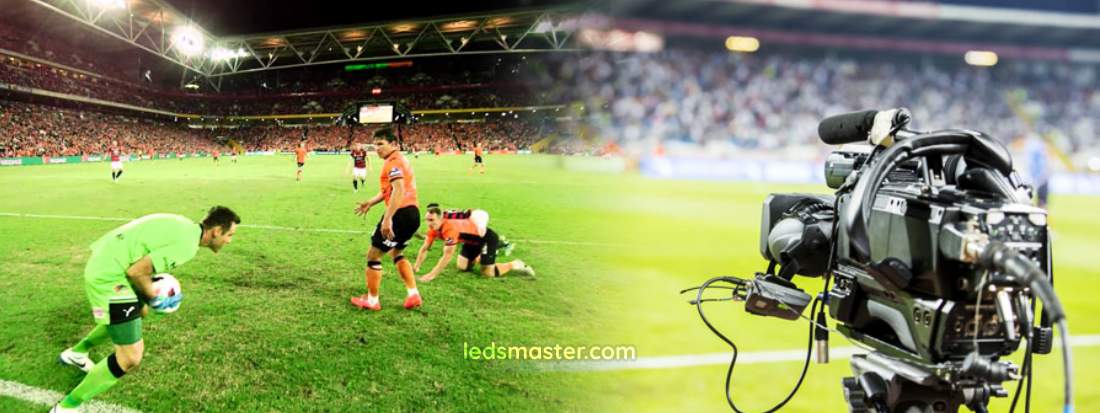
TV Broadcasting Compatibility
In the era of 4K television broadcasting, the requirements for stadium lighting extend to ensuring compatibility with high-definition video production. Our LED floodlights are designed to provide uniform and high-quality vertical luminance, which is essential for capturing detailed and vibrant footage. To support this, we have invested in reducing glare and flickering, which can negatively impact both the visual experience and broadcast quality. Our LED lights incorporate advanced anti-glare optics, including specialized lens covers and coatings, which help to maintain consistent brightness while minimizing distracting glare. These features are crucial for ensuring that both players and audiences experience optimal visibility and comfort, while also meeting the high standards required for modern broadcast quality.
Height of Stadium Roof
Considerations for Luminaire Height
The height at which luminaires are installed in stadiums typically ranges from 30 to 50 meters. This height poses unique challenges for maintaining optimal lighting conditions on the football field. One significant issue is light loss, which is an inherent part of current lighting technology. Despite advanced photometric designs, it is impossible to direct 100% of the light beam to the field. Approximately 30% of the emitted lumen is scattered to the surrounding areas. To address this challenge, two primary strategies are employed: improving optics and increasing the number of lighting fixtures.
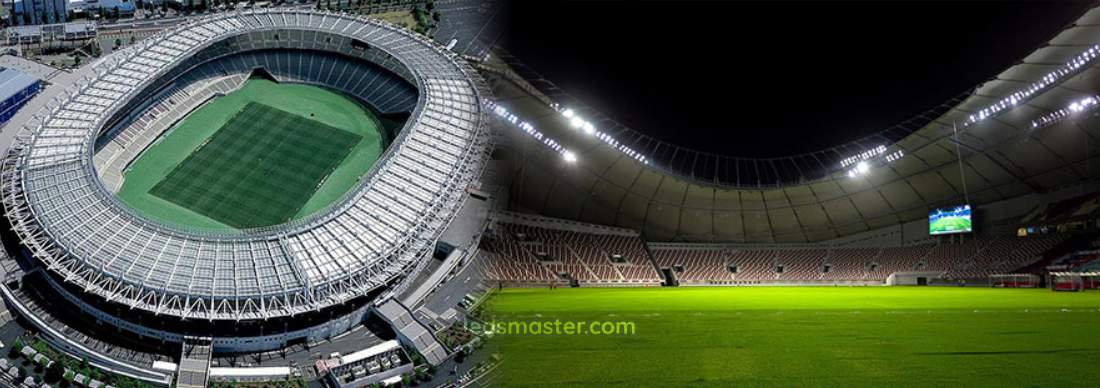
Using Better Optics
One effective method to minimize light loss is to utilize high-quality optics. By adopting advanced LED chips and lens covers, the concentration of the light beam is improved, which helps to reduce brightness loss. However, this approach has limitations. When using such optics across an entire football pitch, uniformity can be compromised. The result can be numerous overlapping circular light spots, which may lead to uneven illumination. To achieve a balanced lighting solution, a comprehensive photometric design is essential. Our engineering team is prepared to assist with this process. For a tailored solution, simply fill out our form for prompt support and guidance.
Increasing the Number of Lighting Fixtures
Another approach to counteract lumen depreciation is to increase the number of lighting fixtures installed on the stadium ceiling. For instance, if the theoretical power requirement is calculated to be 10,000 watts, it may be necessary to install 12,000 to 13,000 watts worth of floodlights to achieve the desired lighting outcome. This method helps to ensure that the field receives adequate illumination despite the inherent losses in light output.
Power of LED Lights Required
Calculating the Total Power Needed
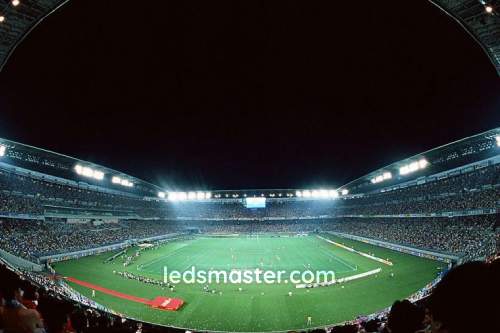 Determining the total power required for stadium lighting involves precise calculations. For example, consider a standard football field measuring 105 meters by 68 meters. The total area of the field is 7,140 square meters. To achieve the required illumination of 2,000 lux across this area, the total luminous output needed is 14,280,000 lumens. With our LED floodlights offering a luminous efficiency of 140 lumens per watt, the theoretical minimum power required is calculated by dividing the total lumens by the efficiency, which amounts to 102,000 watts.
Determining the total power required for stadium lighting involves precise calculations. For example, consider a standard football field measuring 105 meters by 68 meters. The total area of the field is 7,140 square meters. To achieve the required illumination of 2,000 lux across this area, the total luminous output needed is 14,280,000 lumens. With our LED floodlights offering a luminous efficiency of 140 lumens per watt, the theoretical minimum power required is calculated by dividing the total lumens by the efficiency, which amounts to 102,000 watts.
However, this theoretical value does not account for light loss and the height of the luminaires, which must also be considered. When these factors are included, the practical power requirement is approximately 150,000 watts. This highlights the importance of accurate lighting simulations to ensure adequate illumination.
Comparing with Metal Halide Lamps
If the stadium currently uses metal halide lamps, the power requirements will be significantly higher due to their lower lighting efficiency of approximately 70 lumens per watt. For the same football field, the power required would be around 300,000 watts. This comparison underscores the energy-saving benefits of switching to LED lighting, which can lead to substantial reductions in both energy consumption and electricity bills.
Stadium Light Pollution Problem
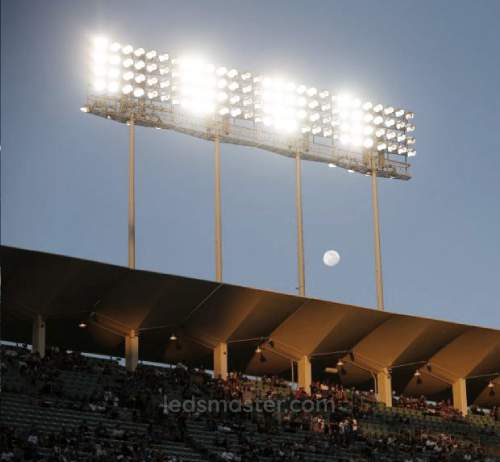 High-quality stadium lighting must also consider the issue of light pollution. Excessive light leakage can significantly affect neighboring residential areas and disrupt the quality of life for local residents. An illustrative case occurred in 2017 in Michigan, USA, where the NFL stadium in Detroit experienced significant light scattering beyond the venue. Residents reported that the brightness from the stadium was intrusive and negatively impacted their sleep, even from distances as far as 5 kilometers away. Additionally, excessive light can pose safety concerns for road users in the vicinity.
High-quality stadium lighting must also consider the issue of light pollution. Excessive light leakage can significantly affect neighboring residential areas and disrupt the quality of life for local residents. An illustrative case occurred in 2017 in Michigan, USA, where the NFL stadium in Detroit experienced significant light scattering beyond the venue. Residents reported that the brightness from the stadium was intrusive and negatively impacted their sleep, even from distances as far as 5 kilometers away. Additionally, excessive light can pose safety concerns for road users in the vicinity.
To mitigate light pollution, it is essential to ensure that the brightness surrounding the stadium does not exceed 25 to 30 lux. This requirement is now a standard part of stadium lighting regulations and aims to minimize the impact on surrounding areas, ensuring that lighting is both effective and environmentally considerate.
Metal Halide Replacement for Stadium Lights
Current Usage of Traditional Lighting
Approximately 45% of football stadiums in the United States continue to rely on traditional lighting sources such as metal halide (MH), high-pressure sodium (HPS), and high-intensity discharge (HID) lamps. Despite ongoing improvements in metal halide lamp efficiency, LED lights have surpassed these traditional sources in performance. Modern LEDs achieve an efficiency of up to 140 lumens per watt (lm/W), whereas metal halide lamps offer about 75 lm/W. For those looking to upgrade their stadium lighting, we offer high-quality LED solutions specifically designed for replacing outdated metal halide systems.
Longer Life Span
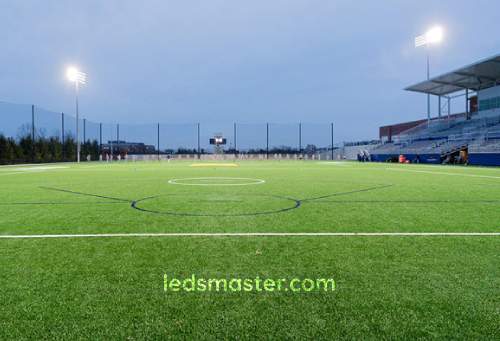 One of the most compelling advantages of switching from metal halide to LED lights is the significantly extended lifespan of the luminaires. Our LED floodlights are designed to last up to 120,000 hours. If the lights are used for 8 hours per day, this translates to a lifespan of at least 40 years with minimal degradation in brightness. LEDs are inherently more durable than traditional lighting technologies due to their solid-state nature. Unlike metal halide lamps, which rely on delicate components such as surface soldering and gold wires, our LED lights are constructed to withstand harsh conditions and extended use.
One of the most compelling advantages of switching from metal halide to LED lights is the significantly extended lifespan of the luminaires. Our LED floodlights are designed to last up to 120,000 hours. If the lights are used for 8 hours per day, this translates to a lifespan of at least 40 years with minimal degradation in brightness. LEDs are inherently more durable than traditional lighting technologies due to their solid-state nature. Unlike metal halide lamps, which rely on delicate components such as surface soldering and gold wires, our LED lights are constructed to withstand harsh conditions and extended use.
Superior Heat Dissipation
The effectiveness of our LED stadium lights is largely attributed to their advanced heat dissipation system. In stadium environments, where lights are required to perform under continuous use and varying conditions, managing heat is critical to preserving both performance and longevity. Our LED floodlights are designed with a sophisticated heat dissipation mechanism that incorporates large, circular aluminum extension fins. These fins serve to significantly increase the surface area available for heat dissipation, ensuring that the heat generated by the LED chips is efficiently transferred away from the light source.
By effectively lowering the junction temperature, our lights maintain optimal brightness levels and extend their operational lifespan. This advanced heat management system helps prevent common issues associated with excessive heat buildup, such as reduced light output and premature failure. The result is a more reliable and long-lasting lighting solution for your stadium, capable of withstanding the demands of high-intensity sports events and continuous use.
Enhanced Durability of Floodlights
When transitioning from traditional metal halide lights to our LED solutions for stadiums, you benefit from a substantial improvement in durability and material quality. Our LED stadium floodlights are crafted from premium polycarbonate and high-grade aluminum alloy, both of which are known for their excellent anti-corrosive properties and resistance to physical damage. This robust construction ensures that our lights can endure the rigorous conditions typical of outdoor stadiums, including exposure to moisture, dust, and physical impacts.
Our LED floodlights are certified with an IP66 waterproof rating, meaning they are fully protected against heavy rain, water jets, and other challenging environmental factors. This level of protection ensures that the lights remain functional and maintain their performance even in adverse weather conditions, offering superior reliability and reducing the need for frequent maintenance or replacement.
Warranty and Support
Selecting LED lighting solutions for stadiums involves not only evaluating the performance and durability of the products but also considering the warranty and support services offered by the manufacturer. Warranty terms are a crucial aspect of this decision, as they provide assurance of the product’s longevity and the manufacturer’s commitment to quality. While many LED manufacturers offer warranties ranging from 5 to 10 years, choosing a company that provides a longer guarantee period can offer additional benefits.
A more extensive warranty period ensures that you receive timely support and service should any issues arise with your stadium lighting system. This added level of protection not only enhances your peace of mind but also safeguards your investment in high-quality lighting. By opting for a product with a comprehensive warranty, you can be confident that your stadium’s lighting system will perform reliably and continue to meet your lighting needs well into the future.
Customized Stadium Lighting Design
A well-executed lighting design maximizes the effectiveness of LED stadium lights and enhances the overall experience for both players and spectators. Our approach to customized stadium lighting design involves a comprehensive, case-by-case analysis to address the specific needs and conditions of each project. This tailored process ensures that every aspect of the lighting system—from lux and uniformity requirements to pole height and weight tolerance—is meticulously considered and optimized.
Step 1: Understanding Your Football Stadium
The foundation of a successful stadium lighting design lies in a thorough understanding of the sports field and the placement of high mast poles. Our initial step involves collecting detailed information about the layout of the football field and the configuration of the lighting poles. This includes creating detailed 3D models to simulate the actual outdoor environment. The accuracy of the lighting plan depends on the quality and extent of the information gathered. Whether the field uses a 4-pole, 6-pole, or round roof arrangement, and the height of the masts—which can range from 30 to 50 meters—are all crucial factors. These details allow us to mount the LED lights appropriately and design an effective lighting solution.
Step 2: Selection of Stadium Flood Lights
For high-profile events like the Premier League, Olympic Games, and other professional football matches, achieving the required brightness involves deploying hundreds of high-power flood lights. Given the unique characteristics of each stadium—such as pole height, lux requirements, and the horizontal distance between the field and the poles—a one-size-fits-all approach is insufficient. Our engineers carefully select the optimal combination of power and beam angle for the LED lights based on these specific parameters. This ensures that the lighting system meets the precise needs of the stadium, providing adequate illumination and achieving the desired lighting quality.
Step 3: Orientation of Luminaries
Once the appropriate power and beam angles are determined, we proceed to adjust the orientation of each luminary. This step involves rotating the lights within advanced lighting design software to enhance ground lighting uniformity. Each luminary’s projection angle is finely tuned to optimize both brightness and uniformity across the field. This meticulous adjustment process helps to eliminate hot spots and shadows, ensuring a consistently well-lit playing surface and an improved visual experience for spectators. For a detailed and precise lighting design, contact us to benefit from our premium orientation services.
Step 4: DIALux Photometric Report
After completing the design and adjustment phases, we generate a comprehensive DIALux photometric report. This report includes false color renderings, isolines, and value charts that provide a visual representation of the lighting performance. The DIALux file offers an in-depth analysis of the expected lighting distribution and uniformity, allowing for final adjustments and verification of the lighting design before implementation. This detailed documentation ensures that the lighting system meets all project specifications and delivers the desired performance.
Stadium Lighting Questions & Answers
What is the Difference Between Flood Lights and Stadium Lamps?
Flood lights and stadium lamps serve distinct roles in lighting sports venues, but their differences are crucial for optimal performance.
Flood Lights vs. Stadium Lamps
Flood lights are designed to provide broad and intense artificial illumination over large areas. They are versatile and can be used across various sports fields to deliver wide-spread, uniform light. When adapted for stadium use, however, flood lights are specially engineered to meet the unique demands of such expansive spaces.
Design Adaptations for Stadium Use
For stadiums, flood lights are equipped with advanced optical designs to ensure long-distance light transmission. The goal is to illuminate the football field effectively while minimizing light scattering that could contribute to light pollution. This requires a redesign of the optics to focus the light over long distances with a wide beam angle, reducing unnecessary light spill.
Additionally, stadium flood lights incorporate aerodynamic features to enhance performance. Our LED lights, for instance, boast an open structural design that improves air ventilation and reduces air resistance. This design is particularly crucial for lights mounted on high masts, where efficient cooling and reduced drag are essential.
Material Considerations
The weight of the flood lights is another important factor. In stadium settings, up to 20 to 40 flood lights may be mounted on a single pole. Using lightweight yet durable materials, such as high-quality aluminum alloy, ensures that the structural support needed is minimal and cost-effective. Heavy lights could necessitate reinforcing the poles, which can be as costly as the lights themselves.
How to Differentiate Between Flood Lights and Spot Lights?
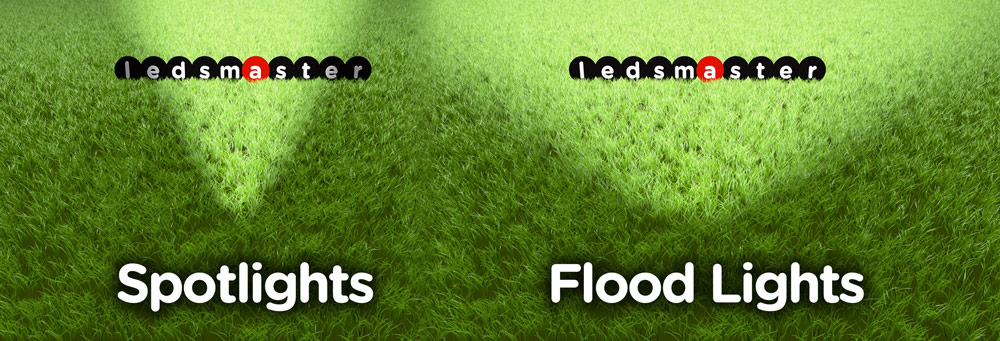
When selecting lighting for various applications, it’s crucial to understand the differences between flood lights and spot lights. These differences primarily revolve around their beam angles and their respective applications.
Beam Angles and Applications
The fundamental distinction between flood lights and spot lights is their beam angles. Flood lights are designed with a broad beam angle, typically ranging from 100° to 120°. This wide-angle coverage allows flood lights to illuminate large areas uniformly. This makes them particularly effective for applications requiring extensive illumination, such as sports fields and stadiums. The wide beam ensures that the light spreads out over the entire area, providing consistent visibility across the field and enhancing the viewing experience for spectators.
Spot lights, on the other hand, have a narrower beam angle, usually between 25° and 50°. This concentrated beam allows spot lights to focus light on specific areas or objects. The narrower beam is ideal for applications that require targeted illumination, such as highlighting particular features or creating dramatic effects. Spot lights are well-suited for tasks that demand precision lighting, where directing the light onto a specific point is necessary.
Sports Field Applications
In the context of sports venues, flood lights play a critical role in ensuring that the entire field is evenly lit. Their ability to provide uniform illumination across a large area is essential for maintaining consistent visibility for both players and spectators. The wide beam angle of flood lights ensures that the playing surface is well-lit, reducing shadows and enhancing the overall experience of the game.
Spot lights, while not typically used for the main illumination of sports fields, serve a valuable role in decorative or supplementary lighting. For example, in stadiums, RGB color-changing spot lights can be installed on the ceiling to create visually striking effects during breaks or special events. These spot lights, with their narrow beam angles of 5° to 10°, can project vivid colors and dynamic patterns, enhancing the atmosphere and engaging the audience in a more interactive experience. This use of spot lights adds an element of excitement and visual interest, making special occasions or moments in the game more memorable.
How Many Watts Do We Need to Light Up a Stadium?
Illuminating a football stadium to professional standards requires a thorough understanding of various factors that influence the total wattage needed. The power requirements for stadium lighting can range significantly, generally between 40,000 watts and 200,000 watts. This broad range reflects the complex interplay of different considerations, including the desired lux levels, the stadium’s scale, and the design of the lighting system.
Factors Affecting Power Requirements
Desired Lux Levels
The lux level, which measures illumination, is a critical factor in determining how much power is needed. Different types of events and stadiums have varying requirements for light intensity. For example, a stadium designed for recreational sports might only need a lux level of 1000, whereas a venue hosting professional sports or high-definition broadcasts may require up to 3000 lux. Achieving these levels requires different amounts of wattage. Higher lux levels necessitate more powerful lighting systems to ensure that every corner of the field is adequately illuminated, providing clear visibility for players and spectators alike.
Scale of the Stadium
The physical dimensions of a stadium significantly impact the wattage required for adequate illumination. Larger stadiums, with extensive fields and larger seating areas, demand more powerful lighting systems. The size of the football pitch and the extent of the seating area both play roles in determining the total power consumption. A more extensive field requires a greater number of lights to cover the entire area effectively. Similarly, a larger seating area needs additional lighting to ensure that spectators have a clear view of the game, which increases the total wattage needed.
Ceiling and Pole Height
The height at which the lighting fixtures are mounted also influences the power requirements. Stadiums with high poles or ceilings necessitate more powerful lights to ensure that the light reaches the field effectively. For instance, high masts used in outdoor stadiums need to be equipped with high-wattage floodlights to cover the distance and provide adequate illumination. Similarly, in indoor or partially enclosed stadiums, the height of the ceiling affects how well the light is distributed across the field. Taller ceilings generally require higher wattage to achieve the desired lighting levels.
Type of Lighting Fixtures
The type of lighting fixtures used in the stadium plays a crucial role in determining power requirements. Traditional lighting options, such as metal halide or high-pressure sodium lamps, are generally less efficient compared to modern LED systems. Metal halide lamps, for example, often consume more power to produce the same amount of light as newer technologies. In contrast, LEDs are more energy-efficient and can deliver equivalent illumination with significantly lower wattage. This efficiency translates into reduced overall power consumption and lower operating costs.
Lighting Design and Distribution
Effective lighting design is essential in optimizing the wattage required for a stadium. The design and distribution of lighting fixtures impact how evenly light is spread across the field. Proper lighting design ensures that the illumination is consistent and well-distributed, reducing the need for excessive wattage. The layout of the lighting fixtures, including their placement and angle, affects how efficiently the light covers the field. Adjusting the beam angle and spread of the lights can enhance the efficiency of illumination, which can, in turn, influence the overall wattage required.
What are the Lumens of Football Field Lights?
Lumens represents the total amount of visible light emitted by a fixture. This metric is especially important when considering the replacement of traditional metal halide lights with modern LED technology. LEDs are renowned for their efficiency and effectiveness, and comparing the lumen output of these lights to their metal halide counterparts helps illustrate the benefits of upgrading.
The lumen output of LED lights varies depending on their power rating, and it is vital to understand these variations when planning a lighting upgrade. Below is a detailed comparison of the lumen output for various power levels of LED stadium floodlights compared to the equivalent metal halide lights.
| Power of LED Lights | Lumens | Metal Halide Equivalent |
|---|---|---|
| 500W LED | 75,000 lm | 1000 to 2000W |
| 800W LED | 120,000 lm | 1600 to 2500W |
| 1000W LED | 150,000 lm | 2000 to 3500W |
| 1500W LED | 225,000 lm | 3000 to 5000W |
| 4000W LED | 600,000 lm | 6000 to 10,000W |
Our LED lights boast a luminous efficacy of 150 lumens per watt (lm/W), which is a measure of how efficiently the light is produced relative to power consumption. For instance, a 1000W LED light with this efficacy produces 150,000 lumens. This high level of efficiency highlights the advantages of LED technology in terms of both energy savings and lighting performance.
To put this into perspective, a 4000W LED fixture can replace metal halide lights with power ratings up to 10,000W while delivering similar or even superior lumen output. The efficiency of LEDs means that less energy is required to achieve the same level of brightness, resulting in lower operating costs and a reduced environmental impact.
Conclusion
Choosing the right lighting for stadiums involves balancing various factors to achieve optimal performance. Flood lights are essential for providing broad, uniform illumination across large areas like football fields, ensuring visibility for players and spectators. In contrast, spot lights with narrower beams are used for targeted effects and enhancing the atmosphere during events.
Upgrading from traditional metal halide to LED lights offers significant benefits, including better lumen output, energy efficiency, and longer lifespans. LEDs provide superior brightness and durability, making them a cost-effective and reliable choice for modern stadium lighting. By understanding these aspects and implementing tailored lighting designs, stadium operators can enhance both functionality and visual appeal.

